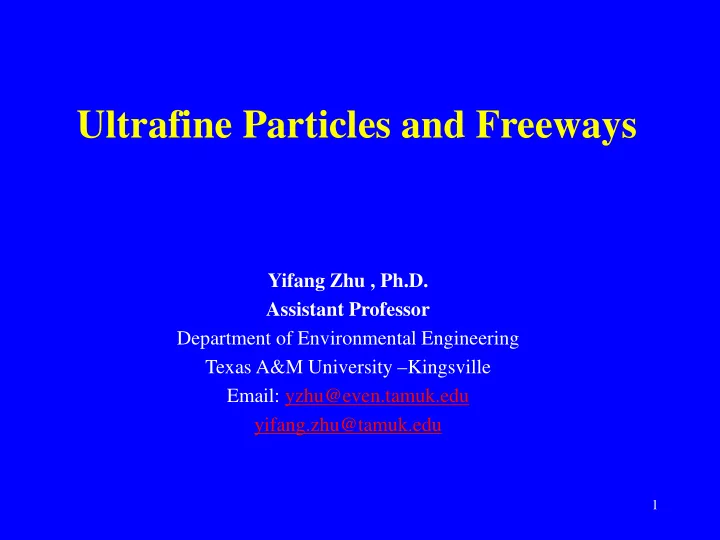

Ultrafine Particles and Freeways Yifang Zhu , Ph.D. Assistant Professor Department of Environmental Engineering Texas A&M University –Kingsville Email: yzhu@even.tamuk.edu yifang.zhu@tamuk.edu 1
Comparison of PM10, PM2.5, and Ultrafine PM PM2.5 Ultrafine PM (2.5 µ m) (0.1 µ m) PM10 PM2.5 (10 µ m) (2.5 µ m) PM10 (10 µ m) Relative size of particles Human Hair (60 µ m diameter) 2
Atmospheric Aerosols: Particulate Matter (PM) Size Distribution Number Distribution Ultrafine Particles Mass Distribution PM2.5 PM10 3 Source: Hinds 1999
Particle Regional Deposition for Light Exercise 1.0 Number Weighted 0.8 Respiratory Deposition, fraction 0.6 Head Airways Alveolar 0.4 Mass Weighted 0.2 Tracheobronchial 0.0 1 10 100 1000 10000 Particle Diameter (nm) 4
Pathways of Particle Translocation Within and Outside Respiratory Tract Translocation of UFP from NP and TB region along sensory neurons to CNS (neurodegeneration) •Translocation of UFP to interstitium, capillaries, heart •Uptake by endothelium; platelets •Activation/interaction of endothelial cells, platelets and leukocytes Alveolar inflammation 5
Publications Address Ultrafine Particles 500 400 Before 1996 1996-2005 Number of Publications 300 200 100 0 Pollution Health Toxcicity Cardiovascula Asthma 6
7
I-405 Freeway 8
Sampling Site Night Day 9
INSTRUMENTS Scanning Mobility Particle Sizer (SMPS): Particle Size Distribution (6-300 nm) Condensation Particle Counter (CPC): Total Particle Number Concentration Weather Wizard III: Wind speed and direction Portable Aethelometer: EC Q-Trak: CO, CO2, Temp, Rh Dust Trak: Real time PM10, PM2.5 10
Experimental Setup: 2001 Daytime 11
Traffic Effect: Total Particle Number Concentration & Traffic Density 12 Zhu et al., 2002a
Normal Traffic Traffic Slowdown 13 Zhu et al., 2002a
RESULTS: Change in Ultrafine Particle Size Distribution with Increasing Distance Day 14 Zhu et al., 2002a
RESULTS: Number Concentration for Different Size Ranges Vs. Increasing Distance from Freeway 405. 15 Zhu et al., 2002a
RESULTS: Relative Particle Number, Mass, Black Carbon, CO Concentration, Vs. Downwind Distance from Freeway 405. 16 Zhu et al., 2002a
17
18
Experimental Setup: 2004 Nighttime 19
RESULTS: Decay of Total Particle Number Concentration 2.0e+5 Daytime Dominant Wind Total Particle Number Concentration (cm -3 ) 1.8e+5 Daily exposure to Ultrafine Particles: 1.6e+5 3 folds of difference between the two cases Nighttime Dominant Wind Nighttime Dominant Wind 1.4e+5 1.2e+5 1.0e+5 8.0e+4 6.0e+4 4.0e+4 2.0e+4 0.0 500 400 300 200 100 0 100 200 300 400 500 Western Side Freeway 405 Eastern Side VA Facility LA National Cemetery Distance from the freeway (m) 20
RESULTS: Decay of Total Particle Number Concentration 2.0e+5 Daytime Dominant Wind Total Particle Number Concentration (cm -3 ) 1.8e+5 1.6e+5 Nighttime Dominant Wind Nighttime Dominant Wind 1.4e+5 1.2e+5 1.0e+5 8.0e+4 6.0e+4 4.0e+4 2.0e+4 0.0 500 400 300 200 100 0 100 200 300 400 500 Western Side Freeway 405 Eastern Side VA Facility LA National Cemetery Distance from the freeway (m) 21
RESULTS: Temperature Effect 1.2e+5 Particle Number Concentration/vehicle (cm -3 ) Y=5.17e3+1.17e5exp(-0.071X) R 2 =0.99 1.0e+5 405 Fwy Night Time 8.0e+4 6.0e+4 405 Fwy Winter 4.0e+4 Y=7.35e4-1.74e3X 405 Fwy Summer R 2 =0.98 2.0e+4 0.0 0 10 20 30 40 Temperature ( o C ) 22 Zhu et al, 2006
Indoor Study Sampling Site and Dominant Wind 23 Zhu et al., 2005
I-405 Freeway 24
RESULTS: Effect of distance from freeways Apartment 1 Apartment 2 25 Zhu et al., 2005
RESULTS: Effect of Ventilation Conditions on Size Segregated I/O Ratios 26 Zhu et al., 2005
RESULTS: Effect of Ventilation Conditions on Size Segregated I/O Ratios 27 Zhu et al., 2005
RESULTS: Effect of Ventilation Conditions on Size Segregated I/O Ratios 28 Zhu et al., 2005
In-Cabin Study 29
Outdoor and In-Cabin Size Distribution Time Series 30 Zhu et al., 2007
Average Outdoor UFP Distribution on Different Freeways 31 Zhu et al., 2007
Average In-Cabin UFP Distribution on Different Freeways 32 Zhu et al., 2007
Similar I/O Ratio Profiles on Different Freeways 33 Zhu et al., 2007
Effect of Ventilation Conditions on I/O Profiles 34 Zhu et al., 2007
TAKE HOME MESSAGES • Because of dilution (and coagulation/condensation) ultrafine particles behave like a local source. • Central station monitoring not useful for estimating dose • 1 hr on freeway exceeds 23 hrs away from freeway. • Newer vehicles with recirculation on helps to reduce in-cabin ultrafine particle exposure. 35
TAKE HOME MESSAGES • Most ultrafine particles formed after exhaust leaves the tailpipe • Cooling and dilution both occurring • Cooling increases nucleation • Dilution decreases nucleation • Complex physical process • Sensitive to environmental conditions 36
FUTURE WORD • Assessing Children’s Exposure to Ultrafine Particles from Vehicular Emissions Objective: To identify hot spots in South Texas where school children are likely to be exposed to high levels of UFPs and develop simple models to estimate children’s exposure to UFPs from vehicular emissions. • Using In-Situ Observations to Quantify Emissions from Prescribed Fires in two Grassland-Pine Ecosystems Objective: To directly quantify UFP emissions from prescribed fires on DoD managed grassland and grass-shrub type ecosystems with different fuel types and fuel loadings. 37
FUTURE WORD Master and Ph.D. Students will be Financially Supported in Part by National Science Foundation (NSF) sponsored Center for Research Excellence in Science and Technology (CREST)- Research in Environmental Sustainability for Semiarid Coastal Areas (RESSACA) at Environmental Engineering Department at Texas A&M University-Kingsville. 38
Recommend
More recommend